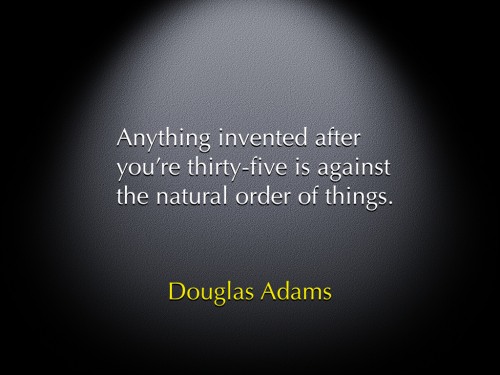
“These sure are exciting times, aren’t they?”
That’s what people say, isn’t it? When, often what they mean instead is:
“These sure are uncertain times, aren’t they?”
… or …
“These sure are freakin’ scary times, aren’t they?!?”
Hogwash, I tell you. These are exciting times. The coming year promises to be filled with success and adventure for companies who keep their wits about them, and who are ready to swing the hammer and take action.
That said, there’s never been a more frightening time to be average at or indifferent about what you do. You have to change. You know the alternative, don’t you?
Sure, life was simpler back then… for you. To paraphrase the late British playwright Douglas Adams, it’s normal for those being born into it and exciting for young people trying to get a job in it.
For you, again paraphrasing Adams, it may very well be against the natural order of things.
It seems like five minutes ago when you could turn on your radio or switch between your three television stations and be perfectly content!
You could walk out to your mailbox and get your handful of daily mail. The only SPAM we knew came in a spiffy little tin.
Unsure who to call? Grab the Yellow Pages.
And now, day after day, we wake up with more choices, more options, more channels, and more noise.
Things are busier, but are they better?
Sorry to say I’m not certain that’s the right question.
I’m not sure it’s helpful or particularly relevant to bury your head in the sand, mumble about the past and long for simpler, sweeter times.
Perhaps it’s best instead, don’t you think, to rise up into the Finding Nemo-esqe slipstream and ride the current into the future?
Want some good news? It’s never been simpler.
There’s never been a better time for you to transform your company’s communications plan and marketing budget.
Want some better news? If you’re good—really good—at what you do, and you like talking about what you do and how you can help people, there’s never been a more financially efficient time in history to gain market share.
So, let’s recap: A number of companies are poised to grab market share in the coming years without necessarily infusing their marketing budgets with huge wads of cash. But, each of these companies has a rather similar set of defining characteristics:
- They’re very good at what they do.
- They like talking about what they do.
- They don’t use economic uncertainty and consumer credit instability as excuses to pull an Eeyore and go all woe-is-me.
- They’re not trying to drive using the rearview mirror.They’re looking ahead with eyes wide open.
- They have a plan.
That last one’s important.
One of the natural side effects of our recent explosion in technology is the sheer heft of voices and choices hurtling toward us. In 2007, the last time market research firm Yankelovich did such an estimate, a person living in a city saw perhaps as many as 5,000 messages a day.
How can you plan to rise above the noise?
Let me give you three simple ways. Just so you know, I learned them from an eccentric futurist who—it should be noted—is probably a whack-job… but stick with me.
Frequency
Imagine a woman calling you—madder than heck—and accusing you of false advertising. Then, you come to find out, she only uses your product every other week, but expects the results to be delivered all the time.
She isn’t using as directed, is she?
Whatever tools and tactics you choose to include in your marketing plan—and that’s really a different subject for a different day—you should plan to deliver your message to consumers for only as long as you plan to be in business.
Customers and potential customers have this annoying habit of caring about things they think are important rather than what we think should be important to them. We’re all too busy, we’re all too alternately focused and distracted, we’re all too over-communicated, unless you tell us and then keep on telling us.
When you understand that you need to be there—in their world—a little bit each week for the rest of your business’ life, you begin to understand the degree to which you must scale your commitment.
Whatever your medium. Whatever your message. Use as directed.
Consistency
Do your messages—again regardless of medium—have the same look, say, and feel?
We’re talking about word choice, pacing, white space, fonts, music and audio signatures, and so on.
Though every President or Prime Minister has a team of speech writers, their mission is singular: to write in the distinctive voice of the leader. The same should be true for all your messaging.
Do they contain certain repetitious elements that allow these super-busy, back-button, over-communicated consumers to easily connect the dots from one of your messages to the next?
Our team first helps our clients develop style guides that assemble—consciously—the defining characteristics of a message plan.
Your elements should fit your business naturally and authentically so there’s no disconnect when a consumer chooses to do business with you, and they, too, should be with you for as long as you plan to be in business.
Relevance
Most critically—given our time and attention poverty—are you talking to consumers about what matters to consumers in a language consumers understand?
Time and again I’ve seen business owners who try and convince me that if the consumer only understood the nuance and intricacies of what they were selling, they’d for sure do business with them every time.
But consumers don’t want to understand. As I said before, consumers have this nagging habit of caring about their own lives, their own worlds.
You’re the invader here. You’re the interrupter. You’d better dadgum-well make it relevant to me, and you’d better do it quickly.
Talk to consumers about what matters to consumers in a language consumers understand.
This is easier than you might suspect. Ask them. Ask your customers! In his magnificent book on customer service, Customers for Life, automotive legend Carl Sewell said intuitively he knew customers knew better, but he “wasn’t sure why. So we started asking customers what they didn’t like about doing business with us, and they told us, quite often without mincing words.”
Mr. Sewell knew, and deep down you know, too. Follow Mr. Sewell’s advice: “I started thinking about our company from the customers’ point of view.
How To Use These Three Tools
Armed with those three tools, you can move forward fiercely into this undiscovered country, ready to gobble market share, whether it be by using web video or local search or radio or print or hiring a bi-plane with a banner … or a combination of them all.
Oh, and the whack-job futurist? Get this: some eccentric scientist evidently rubbed meat paste onto the tongue of a dog over and over again. Every time he did it, he rang a bell. Over and over he repeated this process: meat paste, bell, meat paste, bell, meat paste, bell. Word on the street is that suddenly this dog started drooling when he heard the bell.
Crazy, huh? And for his little experiment in frequency, consistency, and relevance, they gave Ivan Pavlov the Nobel Prize for his research into conditioned response … in 1904.
Ah, the good ole’ days. Exciting stuff, huh?
(Special thanks to my Marketing Yoda, Roy H. Williams, for mentoring me through these exciting times.)



Leave a Reply